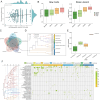Variable phylosymbiosis and cophylogeny patterns in wild fish gut microbiota of a large subtropical river
- PMID: 40152595
- PMCID: PMC12039269
- DOI: 10.1128/msphere.00982-24
Variable phylosymbiosis and cophylogeny patterns in wild fish gut microbiota of a large subtropical river
Abstract
The persistence and specificity of fish host-microbial interaction during evolution is an important part of exploring the host-microbial symbiosis mechanism. However, it remains unclear how the environmental and host factors shape fish host-microbe symbiotic relationships in subtropical rivers with complex natural environments. Freshwater fish are important consumers in rivers and lakes and are considered keystone species in maintaining the stability of food webs there. In this study, patterns and mechanisms shaping gut microbiota community in 42 fish species from the Pearl River, in the subtropical zone of China, were investigated. The results showed that fish host specificity is a key driver of gut microbiota evolution and diversification. Different taxonomic levels of the host showed different degrees of contribution to gut microbiota variation. Geographical location and habitat type were the next most important factors in shaping gut microbiota across the 42 fishes, followed by diet and gut trait. Our results emphasized the contribution of stochastic processes (drift and homogenizing dispersal) in the gut microbial community assembly of freshwater fishes in the middle and lower reaches of the Pearl River. Phylosymbiosis is evident at both global and local levels, which are jointly shaped by complex factors including ecological or host physiological filtration and evolutionary processes. The core microbiota showed co-evolutionary relationships of varying degrees with different taxonomic groups. We speculate that host genetic isolation or habitat variation facilitates the heterogeneous selection (deterministic process), which occurs and results in different host-core bacterium specificity.
Importance: Freshwater fish are regarded as the dominant consumers in rivers and lakes. Due to their diverse feeding modes, fish significantly enhance the trophic link and nutrient recycling/retention in aquatic habitats. For this, they are often considered keystone species in maintaining the stability of food webs in rivers and lakes. A significant part of fish nutrition is essentially mediated by their gut microbiota, which can enhance fish tolerance to fluctuations in external resources and improve the efficiency of nutrients extracted from various food sources. As gut bacterial symbionts have a profound impact on the nutrition and development of their hosts, as well as their overall fitness, it is critical to answer the question of how hosts maintain these benefits by procuring or inheriting these vital symbionts, which is still largely unanswered, especially for freshwater fish. Our study provides new insights into the co-evolutionary relationship between wild fish and their symbiotic microbiome, the hidden diversity of gut microbiome, and the ecological adaptation potential of wild freshwater fish.
Keywords: Pearl River; assembly; co-evolution; fish; gut microbiota; phylosymbiosis.
Conflict of interest statement
The authors declare no conflict of interest.
Figures




Similar articles
-
Unveiling the co-phylogeny signal between plunderfish Harpagifer spp. and their gut microbiomes across the Southern Ocean.Microbiol Spectr. 2024 Apr 2;12(4):e0383023. doi: 10.1128/spectrum.03830-23. Epub 2024 Mar 5. Microbiol Spectr. 2024. PMID: 38441978 Free PMC article.
-
Geographical distance, host evolutionary history and diet drive gut microbiome diversity of fish across the Yellow River.Mol Ecol. 2023 Mar;32(5):1183-1196. doi: 10.1111/mec.16812. Epub 2022 Dec 14. Mol Ecol. 2023. PMID: 36478318
-
Host species and habitat shape fish-associated bacterial communities: phylosymbiosis between fish and their microbiome.Microbiome. 2023 Nov 20;11(1):258. doi: 10.1186/s40168-023-01697-6. Microbiome. 2023. PMID: 37981701 Free PMC article.
-
A review on comparative analysis of marine and freshwater fish gut microbiomes: insights into environmental impact on gut microbiota.FEMS Microbiol Ecol. 2025 Jan 7;101(1):fiae169. doi: 10.1093/femsec/fiae169. FEMS Microbiol Ecol. 2025. PMID: 39719366 Free PMC article. Review.
-
Ecological and evolutionary mechanisms underlying patterns of phylosymbiosis in host-associated microbial communities.Philos Trans R Soc Lond B Biol Sci. 2020 May 11;375(1798):20190251. doi: 10.1098/rstb.2019.0251. Epub 2020 Mar 23. Philos Trans R Soc Lond B Biol Sci. 2020. PMID: 32200746 Free PMC article. Review.
References
-
- Yukgehnaish K, Kumar P, Sivachandran P, Marimuthu K, Arshad A, Paray BA, Arockiaraj J. 2020. Gut microbiota metagenomics in aquaculture: factors influencing gut microbiome and its physiological role in fish. Rev Aquaculture 12:1903–1927. doi:10.1111/raq.12416 - DOI
-
- Minich JJ, Härer A, Vechinski J, Frable BW, Skelton ZR, Kunselman E, Shane MA, Perry DS, Gonzalez A, McDonald D, Knight R, Michael TP, Allen EE. 2022. Host biology, ecology and the environment influence microbial biomass and diversity in 101 marine fish species. Nat Commun 13:6978. doi:10.1038/s41467-022-34557-2 - DOI - PMC - PubMed
-
- Zhou S, Rajput AP, Mao T, Liu Y, Ellepola G, Herath J, Yang J, Meegaskumbura M. 2022. Adapting to novel environments together: evolutionary and ecological correlates of the bacterial microbiome of the world’s largest cavefish diversification (Cyprinidae, Sinocyclocheilus). Front Microbiol 13:823254. doi:10.3389/fmicb.2022.823254 - DOI - PMC - PubMed
MeSH terms
Grants and funding
- 2023CXYC6/Scientific Innovation Fund, PRFRI
- 2018YFD0900902 2018YFD0900902/National Key Research and Development Program of China
- 2019B1515120064/Basic and Applied Basic Research Foundation of Guangdong Province
- Project of Financial Funds of Ministry Agriculture and Ruaral Affairs: Investigation of Fishery Resources and Habitat in the Pearl River Basin
- 2023TD10/Pearl River fishery resources investigation and evaluation innovation team
LinkOut - more resources
Full Text Sources
Research Materials
